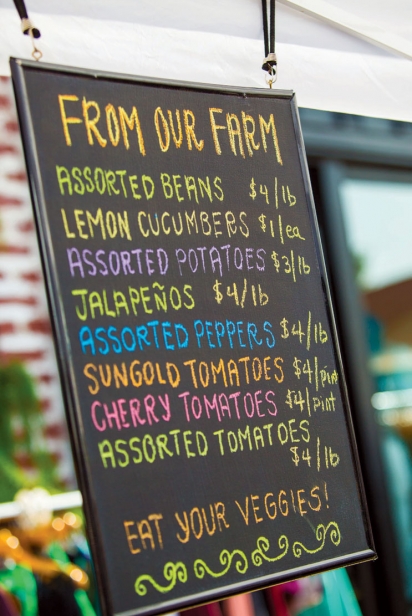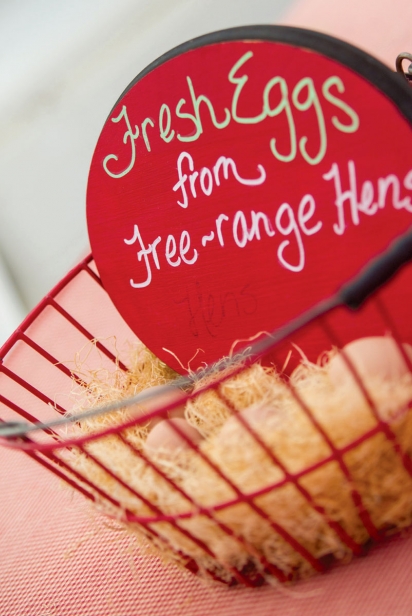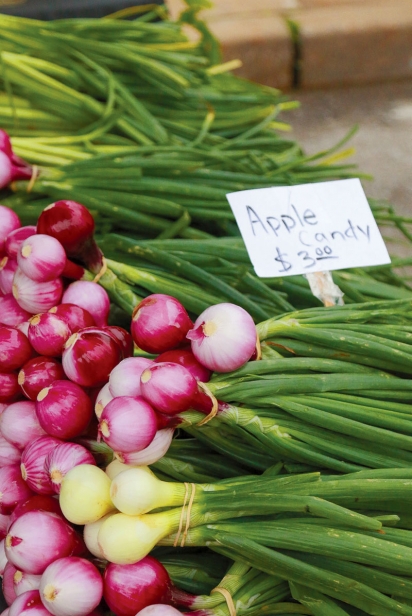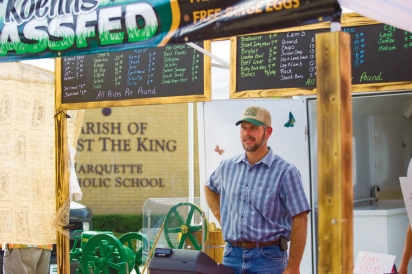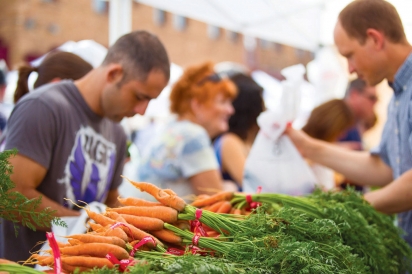Backstage at the Farmers Market
Long days, nonstop pace produce weekly festival of foods
It’s 3:30 in the morning and already you are running late. Must be a strange feeling. I’m more used to being on the other side of this equation, bleary-eyed at the night’s end, not wide-eyed and sleep-deprived at the shaky start of a new day. It’s a weird inversion.
And all at once, it’s very clear: If you’ve ever thought that it’s hard to get out of bed on a Saturday morning to bother seizing the day and attending the farmers’ market, you’ve got nothing on the people who actually work the thing. Say it again with me—3:30 is running late.
Take Mike Leslie, assistant manager of the Cherry Street Farmers’ Market Association. Just as Friday night’s parties are getting slow and shutting down, Mike is on the ground at Cherry Street, running up and down the stretch of road just east of 15th and Peoria, blocking off the street with heavy ROAD CLOSED and DETOUR signs, reinforcing them with sandbags, barricading the entire area that will, in hours, make up the farmers’ market—and he’s doing it by himself. In the dark. It takes him about an hour and 15. All this, he says, is to make it safe for the vendors.
“At 5am,” he says, “we shut the whole street down.”
The vendors begin creeping in on their own time, according to their own schedules and setup needs. Like the Blakleys of Blakley Family Farms, who rise on their land in Oologah at 3am for a 5am setup here in the heart of Tulsa. Or Micah, with Gold Standard Honey, whose family gets up at 3 for a 45-minute drive southwest from Adair, arriving with the sun at 6 to set up their whole storefront in the hour that remains.
With daylight comes the sober realization that it looks like rain today, like really, in an inevitable and physical sense, as swollen clouds loom overhead, looking ready to burst, any second now. But the show will go on, rain or shine. Too much has been sunk in to the day already—they’re pot-committed.
Did you ever try to set up a lemonade stand as a child, and quickly come to realize that it’s harder than it looks? I doubt you made a profit; I question if it was even that much fun. This work is more than just showing up. Any fool can hawk radishes on the street at random passerby for a quarter a bundle, but actually moving product? That takes savvy. And it’s delicate. One must make their booth presentable. Arrange their cabbage heads just so.
At 6:30, Cherry Street is a sleepy village, stretching after waking up. The street buzzes with bird chirps and clipped mumbles of family shorthand, conversations that progress entirely with an interchange of “hm?” “Hm.” “Mm-hm.” “Mmm.” Competing vendors exchange warm smiles and good mornings—familiar faces, all. It’s the kind of thing to see that makes your world feel smaller, in a good way. You’d think these interactions would be more cutthroat, or at least slightly more cold. Aren’t these people technically competing with each other?
“There’s competition—a word for it that you could use is ‘cooperatition,’” says Michael Appel of Three Springs Farm, wakeup time 2:30, for setup at 5am. “We all have good days, and we all struggle.”
As he talks he stays in constant motion, carrying one box into one van and emptying these things into that, arranging his colorful produce display, wary always of the ticking clock. One notices that his setup cleaves to classic market principles—his surplus items center stage, the red leaf lettuce set between two green ones, to differentiate, and please the eye.
You can’t help but observe, actually watching the setup process, that this is a lot of roles for one person to play over the course of a day—a Saturday, even, and all of it well before lunch. You wake up a farmer, you labor and drive, and then you must construct your storefront, design it in a way that’s most appealing, most suited to your needs today. And then you must become a salesman, a good one, and unique, with more to offer, more appealingly than the 50, 60 salespeople up and down the street in cooperatition with you. At the end of the morning, you must tally up your business, redeem the market’s token currency for hard money, and reckon with the financial realities of your independent enterprise. Then—and only after a long drive and offload back at home—can you return to being a mom, dad, child, normal person—and sleep. Michael all but confirms it: “Sunday’s a recovery day.”
Indeed. Good. And well-deserved—Saturday is the business day, when everything gets done. A four-hour stretch from 7 ’til 11, in which some vendors need to make all the money that they’re going to make that week—until next market. “We’ve got no income other than farming,” Michael says, as much to himself as to me the market’s opening nears, the wind picks up, and the clouds go ever darker. “It’s gotta be a good day.”
By 5 after 7, the market is officially open—and populated. Everyone’s coffee has kicked in. The sleepy village has, all of a sudden, woken up. Spice and fruit notes are picked up on the wind with the smell of rain. It’s much busier than you’d think for a day that looks like a downpour is inevitable, and if you’ve ever found yourself wondering whether or not the farmers’ market is for you—whether you’ll fit in with the crowds or cluelessly stick out—be assured that there’s nothing to worry about. You couldn’t possibly be weird enough. You’ll see a man in a bow tie walk sideby- side with a girl straight-up in her pajamas. Tired RNs on their way to work, families, a whole racial rainbow. A baby with arugula hanging out of his mouth.
Strains of countrified solo guitar music lilt gently down from one end of the street to the other, flirting with the cracklings of a wooden ice-cream maker center stage at Koehn’s Grassfed’s tent hard at work, pumping and grinding away. It’s a carnival atmosphere, but cleaner, more fragrant, more inviting than that phrase has come to suggest. It’s a carnival you’d actually want to go to—an interesting mix, as Mike Leslie puts it, of the agriculturally and artistically inclined.
I used to never go to the farmers’ market. Yes, I thought it was too early—for college-slacker-student Sarah, the hours of 7 to 11am may as well not have existed—but I also didn’t know how I could benefit from it. What’s in it for me? Legitimately. I didn’t know how recently the fruits, the breads, the meats that you could buy were all prepared; I didn’t know how good some food could taste. I didn’t feel like I could shift my shopping habits to one Saturday for stocking up; I had no idea how good it’d make me feel.
Some vendors recognize this, this reticence, this cluelessness, and strive to correct it—like Angelina Pushkar, founder of Aviva Fine Foods, master baker and mother of six, who wakes up at 4 to get here at a quarter past 5. She recognizes the educational opportunities in a direct-to-customer sales environment, relishes them, occasionally teaching classes on food at Oklahoma State University; she’s also in her fourth season of selling at OSU’s farmers’ market, on campus in Stillwater. “Visiting makes you think,” Angelina says, referring to the groups of students she has seen come by, either on assignment—some undergraduate classes are occasionally required to, say, prepare a meal using only the most local of ingredients—or simply curious on their own, to ask questions about her breads, cakes, their benefits and how to make them. The simplicity of baking when it’s not done for mass consumption, loaded with preservatives and flavor agents for maximum profit.
“Thirty ingredients in one bread, it raises the flag,” she says—she’s right—and she’s happy to educate anyone who asks on how few ingredients you really need for good bread, made with Old-World techniques. All of hers for sale today was made within the last 24 hours.
She talks of ways to make inquiring minds more literate in the field of food. “Can you read the ingredients? Can you pronounce them?”—things like that. But she’s also had questions from people who have never seen zucchini. Regardless, she covers all the subjects that she can, all as part of a mission to open up a dialogue with people regarding the background of their food, to help them understand, and be more comfortable with, buying direct, cooking for themselves and eating better.
“It’s forming the habit for lifelong decisions,” she says, of the many benefits that come from eating well, and knowing it. Of having confidence in your own nutrition, both from the advice you receive from a learned chef or farmer, and the food that you take home from them, and incorporate into your world. “You have to knead this into your social life. For families, time at the market is time together. This is what people remember for a lifespan.”
And as she talks, there I am, inwardly tsking at my college self, asleep somewhere, paying equal money for inferior food, when all this is available, so sincerely more enjoyable. Talk to her if you’re not convinced— Angelina has an ability to convert you. Buying supermarket bread from a mass-producing bakery—“What’s the point?” she asks. “Truly.”
By 7:30, the market is fully in business, and the languid motions of a half-awake pre-dawn setup have been thoroughly replaced by the quick movements of commerce, the bright eyes of the hustle. This is work, for the vendors and market administration both. At the market association’s booth, Mike Leslie, administrator Penni Shelton and market manager Lisa Brandborg pivot between talking to me, speaking with customers and exchanging credit card swipes and food stamps with the equivalent value of the market’s wooden tokens.
It’s even better to come with food stamps, where there’s a built-in deal that matches your SNAP funds up to $20, with special tokens to be spent on fruits and vegetables—free money, bonus bucks. A lot of these change hands every minute—you can’t stop paying attention for too long. You can see the sort of effort it must take to run the place long-term in Lisa’s eyes, her stance, her tone of voice. She strikes you as the sort of person who is long past wondering what could go wrong, and instead is quietly, wisely, already planning for the eventuality.
But these routine stresses and the threat of weather are not enough to darken anybody’s spirits. In a way, this is not surprising—especially for Mike, who grew up in the bread basket of California, and became familiar during his time there with the yearly, tireless, thankless routines of migrant workers who roved up the coast with the seasons, following the harvest. He has seen their Sisyphean work, their tolerance for conditions always lower than ideal.
Raindrops sprinkle and splatter the pavement, but it feels abortive and lame—by now it’s as though the rain is being held back by little more than the sheer will of this market, fingers everywhere crossed tight to breaking. It’s been a common refrain not just today, but all season—too many crops lost to the rain. Give us this day, at least. Let us have these morning hours.
At 8am, the sun comes out—there will be no rain today. Not this morning, not when it matters. Those pregnant skies break for other fields, and these vendors get their hours in, engaging with the crowd ’til an hour to noon, indulging in that these-days-rustic but so-rightfeeling direct communion with their consumers.
“It’s not a cliché, it’s not a put-on,” stresses Michael, with three Springs. “I love the relationship we have with our customers. I truly love it.”
Shortly before 11, Mike Leslie strolls the street, breaking vendors from their tunnel vision to let them know they’re shutting down. Everyone quietly sets to putting away their tables, their placards, their unsold stock. The weariness starts sinking in. This is the hardest part, for Mike—when he collects the signs: They need to go back in the truck in a certain order, or the next time he has to offload them he’ll face a disorganized, tiresome mess.
By noon, by law, the street must open—so it does. The signs get put away, the vendors drive back where they came from, and the market disappears, like it was never there at all, fading back into the daylight like a half-remembered dream.




